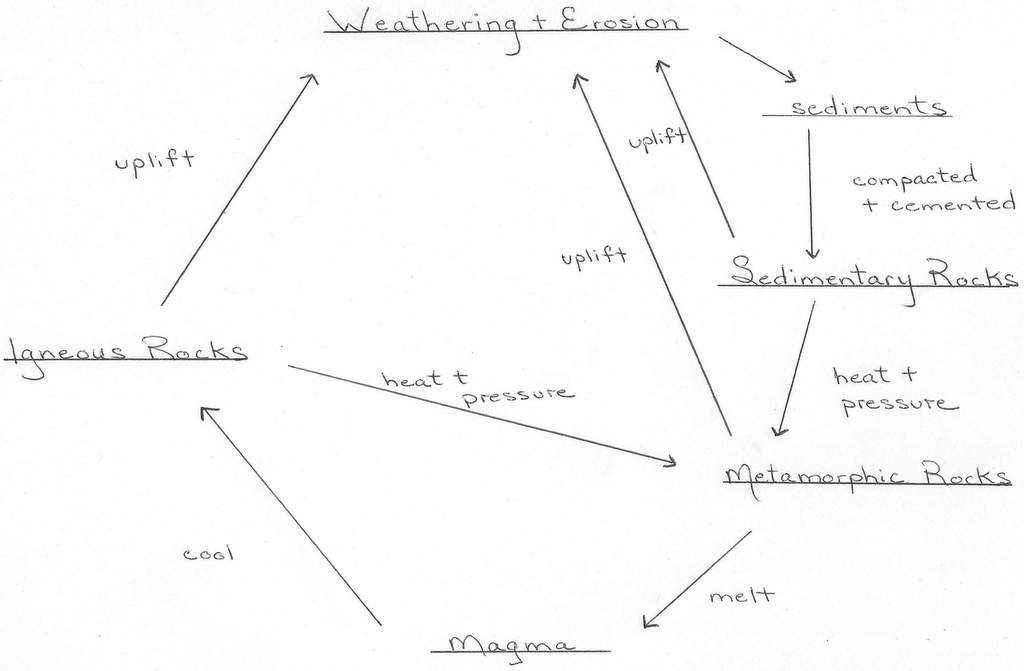History
Our planet has 4 layers:
1- the outer crust: the solid outer layer we live on
2- the mantle: where magma, semi-solid rocks and minerals are
3- the outer core surrounding the very middle: made of a mixture of iron and nickel
4- the inner core: the very center of the earth, a ball of mostly solid iron
Simply there are 3 types of rocks: Igneous, Sedimentary and Metamorphic.
The rock cycle: (see diagram) Igneous rock is created from cooling magma or lava. It can then be altered by heat and pressure changing it into metamorphic rock or uplifted, weathered and eroded into sediments. Sediments are compacted and cemented together to form sedimentary rocks. Sedimentary rocks if uplifted, weathered and eroded again will form more sedimentary rocks or under heat and pressure will be altered to form metamorphic rocks. Metamorphic rocks can be uplifted, weathered and eroded into sediments and then when compacted and cemented will create sedimentary rocks or if melted will produce more magma.

IGNEOUS Rocks
= rocks formed from the cooling and hardening of magma (hot liquid rock)
Rocks in the earth, deep inside the mantle, are under a constant change of high pressure and high temperatures causing them to melt. Others are in a semi-liquid state. Melted liquid rock is called magma. When magma is exposed on the surface of the earth it is called lava or molten rock. Igneous in Latin means fire-formed.
When magma cools into solid rock then crystals are formed. There are different kinds of igneous rock depending on the rate the solid rock had cooled, where it cooled, and the differences in the chemical compositions.
Igneous rocks are created 2 ways:
Intrusive Igneous Rock: forms when the rock cools slowly while still under the surface of the earth. Visually it has large coarse-grained mineral crystal specks of different colours.
Extrusive Igneous Rock: is created when liquid magma (forced up out of the earth through volcanoes) cools very quickly on the surface of the earth because it is exposed to air or water. The rapid cooling process does not give enough time for crystals to grow very large. This rock is therefore made of very fine grains and crystals.
Textures of Igneous Rock (6 main ones)
Aphanitic: extrusive (formed on the surface) / fast cooling / grains are too small to be seen with the unaided eye. Examples of stony and dull aphanitic rocks are: felsite (light coloured and fine grained) and basalt (dark coloured and fine grained)
Glassy (volcanic glass): extrusive (formed on the surface) / near instant cooling / no or very few crystals have time to form during solidification of lava. Example: obsidian (dark silver gray to black, shiny)
Pegmatitic: intrusive (formed under the surface) / rocks who’s crystals grow to large sizes ranging from 2.5 cm to a few meters
Phaneritic: intrusive (formed below the surface) / slow cooling / grains are large enough to be seen with the unaided eye. Example: granite, gabbro, diorite
Porphyritic: having a mixture of large grained crystals amongst a finer grain groundmass. Initially slow cooling deep down, grows large crystals and the final cooling (at a shallower depth or as it erupts from a volcano) is rapidly. It is possible the groundmass has an aphanitic quality. Example: Basalt is an aphanitic porphyrite rock; granite is a phaneritic prophyritic rock
Pyroclastic (fire fragments): extrusive (formed on the surface) / lava solidifies almost instantly during the eruption of a volcano. Occasionally, tiny holes form when gas bubbles are trapped and expand (or water is trapped) during this process creating a frosty texture. Examples: pumice (vesicular rough textured), scoria (cinders)
SEDIMENTARY Rocks (known also as Secondary Rocks)
= rocks formed from compacting & cementing together sediments
Sedimentary rocks are made from layers of broken sediments (sand, pebbles, rock, minerals, plant, animal, etc.) that have compacted and cemented together over billions of years at the earth’s surface or in water. These rocks can contain fossils.
Layers of sedimentary rock are formed mostly parallel to the earth’s surface. If the layers are on an angle or broken this indicates a movement of the earth has occurred.
Sedimentary rocks are created 3 ways:
Clastic Process - eroded, broken and weathered bits of rock transported by gravity to lower areas on earth (example by wind, water, glaciers) where more erosion and chemical changes occur, reducing the particles to much smaller grains, affect the formation of these sedimentary rocks
There are 3 main groups of clastic rocks:
a) those made of gravel fragments called conglomerates or breccias. Example: the rocks can be constructed of quartz or sedimentary, metamorphic or igneous rock fragments bound together with a mixture of sand, mud and chemical cement
b) those made of mud, clay, or silt or a mixture of these called mud-rocks. Example: shale is formed from bits of clay
c) those created with quartz, feldspar or lithic mineral components. Example: sandstone is composed of sand-sized fragments of quartz
2) Chemical Process - when water evaporates leaving behind dissolved minerals affecting the formation of these sedimentary rocks. Example: thick deposits of salt from the repeated action of flooding and evaporation forms rock salt
3) BioChemical (Organic) Process - when the formation of sedimentary rocks is from the accumulation of organic debris such as shells, coral, plants, carbon, etc. Example: the formation of coal is from the accumulation of plant debris and rock sediments
Texture of Sedimentary Rocks
The grain size and orientation of the clasts (broken fragments that make up the sedimentary rock: minerals, pre-existing rock, shells, etc.) are used to determine how they are formed and what they are formed of. Individual pebbles and/or sand grains can be visible. Colours may also be present.
Sedimentary rocks may break apart or crumble easily.
METAMORPHIC Rocks (meta=change) (morph=form)
= rocks formed by altering the chemical make up of the original (parent) rock with a process of heat or heat & pressure
Igneous or sedimentary rocks that have been buried deep into the earth are squeezed by other rocks on top of them pushing them down further exposing them to high heat. Intense pressure and temperatures transform the minerals and chemicals. This alteration can happen by: changing the mineral configuration - growing larger or breaking down and forming new minerals; or by reacting to fluids that have entered the process. The kind of new rock that is formed depends on which types of rocks are used in the process and how long the process takes. Example: marble is made from limestone makeup and sometimes dolomite
Textures of Metamorphic Rocks
Metamorphic rocks are the hardest type of rock and are therefore more resistant to erosion and weathering. Some show shiny crystals. Foliated textures (those subjected to uneven stresses of pressure) have materials aligned in ribbon-like layers or planes. (Example: slate {fine grained}, gneiss {coarse grained}) Nonfoliated textures show impurities but no visible alignment. (Example: marble, quartzite, hard coal)
Two types of metamorphisms are:
a) regional: occurring over hundreds of miles/km usually associated with the faulting and folding processes, involving intense heat and pressure, that create mountains, foliated textures occur
b) contact or thermal: occurring over a smaller areas where hot magma comes in contact with the surrounding rocks and alteration occurs due to intense heat
Rocks have different colours due to:
a) minerals - come in a variety of colours (example quartz comes in many colours)
b) temperature - due to the chemical make up of minerals, crystals will form at different temperatures. Example: minerals that are able to crystalize at high temperatures will make those rocks dark in colour.
c) iron (II) oxide - gives the rock a colour of grey or green
d) iron (III) oxide - gives the rock a colour of red to brown
e) oxidization - of organic material in arid climates gives the rock a red to orange colour
f) lack of oxidization - of organic material, in underwater environments, gives the rock a black or grey colour
Conglomerate Rock
Conglomerate means to form into a mass. Many variables are involved to create many different kinds of conglomerate rock: the amount and kind of fragmented material (clasts), the kind of material in the mold (matrix), where and how long it formed.
There are two classes a) when the clasts are not in contact with each other and the cementing material surrounds each – ‘matrix supported’ b) when the clasts are in contact with each other – ‘clast supported’. Sorting is another way of identifying these rocks: a) poorly sorted labels are given when clast sizes vary b) well sorted means the clasts are mostly the same size.
Conglomerate rocks are well suited for use in decorating walls and floors. If the rock materials are hard enough they can be used in construction and roads.
Why Conglomerate
We came upon this unusual wall with the look of the individual large rocks sheared off level with the larger parent rock. When we (the Cos) normally think of conglomerate rocks we think of an art project where palm-size or smaller stones look like they have been glued onto a once-soft boulder. In this case, we find them embedded completely in the parent rock.
Questions
Please observe the raw rock specimen at this location by finding, if possible, a freshly fractured surface rather than a weathered surface - anywhere along the wall. From your observations and using the above rock information, please answer the following.
a) Estimate the size of the largest clast you see?
b) Would you classify this rock wall as well or poorly sorted?
c) Is this rock matrix or clast supported?
d) Estimate the size of the entire exposed rock sample above ground:
e) From your observation and reference to this cache page does the rock you are studying belong to the Igneous, Sedimentary or Metamorphic rock group?
Those who send answers will receive a bonus.
Photos of you in the area are always nice to see and add to the interest of the geocache page. Please consider adding some of your own.
Favourite: If you like this Earthcache, please consider giving it a favourite point so others will know you enjoyed the experience. Thanks a bunch for visiting ~ We hope you have enjoyed learning about Conglomorate Rocks. Rock On...
CedarNCo have earned (GSA) Geological Society of America's
highest earthcache level: |
 |
Platimum Earthcache Level is awarded by Geo Society .org for visiting and logging 20 or more EarthCaches in 5 or more states/provinces/countries and have created 3 or more EarthCaches.
|
Garnet Discovery Award is awarded by
Geo Society .org for visiting and logging
250 or more EarthCaches.

|
space space space space space space space space
Please Keep the Earth Clean

|